A cold wind blew today but it was impossible to feel downbeat as the sun was shining from an unsullied blue sky. To avoid the worst of the wind I went to some woods near to me that were a mixture of dark green conifers and bare limbed, deciduous trees. The sunlight shone bright and strong from on high, creating ripples of light on the floor of the wood as it permeated through the green fronds of the conifers and the skeletal boughs and twigs of the deciduous trees. A lemon yellow Brimstone flew in a fast, flickering flight, threading its way through the tree trunks and passed across the bare, earthen brown and occasionally green brambled floor of the wood. Looking up through the trees the intense blue of the sky showed as irregular patches of bright colour in the spaces between the wind disturbed tree tops and the sun's intensity created a hard white light that caused me to shade my eyes,
This morning it was as though the heart and hidden recesses of the wood that had remained dormant through the dark of Winter were now being laid open by the streaming rays of the sun welcoming Spring, and the chilling wind was banished to the very tops of the trees. It was consequently quiet and undisturbed beneath the trees and only the sound of invisible birds came to me from high above in the tree tops. On a corner of a green ride where the grass was bejewelled with the star like shiny yellow flowers of celandines, the sound of finches came from some large Alders, their upper reaches heavy laden with a confused jumble of tangled twigs and small knobbled cones. Staring upwards I could at first see nothing, as the finches were tiny and hidden in the tangle of cones but every so often a bird would flutter to another branch, changing its position and as it did so betray its presence.
Looking up in the binoculars I would find it and almost certainly I would then find its companions all busily feeding on the seeds of the cones. Lesser Redpolls, Siskins and Goldfinches were amicably sharing the tree tops keeping up a constant conversational twittering in the case of the Goldfinches whilst the Siskins communicated with that melancholic whistle of theirs and the Lesser Redpolls responded with a dry rattling trill. Each call distinctive and making it un-necessary to see the bird if one knew the various calls.
I moved onwards and the faint, high, sibilant calls of a pair of Goldcrests came to me from the conifers. Tiny, dull moss green and grey buff birds with a gash of golden yellow on the crown in the case of the male and plain yellow for the female. Their song and calls are of such a high register that they are often impossible to hear after we reach a certain age but although I am a fair way beyond the age when it is considered beyond my powers, I can thankfully still hear them. There were today, however, two very similar songs coming from the trees and to my delight I realised that the other song was that of a Firecrest.
It took some time to find it, as it is no easy task seeking a bird less than the size of my thumb in the dense spiky green needles of the conifers and I only located it when it flitted from a dark recess of the conifer onto an isolated hanging branch of needles.
Often one only sees Goldcrests and Firecrests for the briefest moment, as minute silhouettes against the light or as tiny scraps of life easily mistaken for a falling leaf as they move high up from one tree to drop lower to another but occasionally they will come very low in their quest for food and can be seen at head height and, exceptionally, even lower in the bramble leaves that grow under some of the trees here.
They are constantly on the move, never ever still, as they endlessly and diligently search every leaf and conifer frond for food to sustain their hyperactive life. Today I was very fortunate as a pair of Firecrests gradually came lower and lower until they were just above my head and flitted around on some bare twigs before one descended almost to the ground, hunting through some bramble leaves growing around the base of a tree trunk.
Firecrests are beautiful, in fact they are breathtakingly beautiful. Similar to a Goldcrest in size but there the similarity ends as although the patterning of the two species is superficially the same the overall colouring of the Firecrest is so much more intense, with the green on their back suffused with golden bronze and unlike the plain faced Goldcrest, the Firecrest's face has a strikingly smart combination of white above and below the eye with a black stripe running through the eye, and possessing a black crown in the centre of which is a crest that really is on fire, being bright orange yellow with a centre of burning red only revealed in display. They are the crown jewel of any wood they inhabit. Always eagerly sought after and like any elusive bird, they require dedication, a considerable amount of luck and some perseverance to see them well.
Today I found my feathered jewel and although I could not keep it at least I managed to capture it on camera and so keep the memory alive.






No comments:
Post a Comment